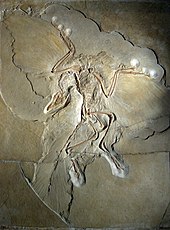Sinornis
When it was described in 1992, this 120 million-year-old sparrow-sized skeleton represented a new avian sharing "primitive" features with Archaeopteryx as well as showing traits of modern birds.
[1] The holotype skeleton of Sinornis, BPV 538a-b, consists of a plate and counterplate of fine-grained freshwater lake sediment as proven by numerous fish, insect, and plant remains.
Sinornis shares a similar pelvis with the latter genus, but its pelvic girdle has free elements unlike the fused ones found in modern birds.
[1] Discovered by a Chinese farmer prior to 1992, the fossil of Sinornis sheds light on the evolutionary steps that transitioned birds into strong, specialized flyers.
Paul Sereno of the University of Chicago and his colleague Rao Chenggang of the Beijing Natural History Museum were the first to name and describe the skeleton of Sinornis.
Sinornis shared many traits with modern birds while retaining certain basal characteristics of Archaeopteryx, so that in 1992 it could be presented as the missing link in avian evolution.
However, also in 2001, Zhou and Hou continued to distinguish Cathayornis from Sinornis by the former's larger size, a shorter, straighter, finger number I, with a slightly longer claw (ungual), the absence of an atitrochanter, and other features.
[5] Based on features present on the preserved skeleton of Sinornis, it shared similarity in flight performance and perching capabilities to sparrow-sized birds living today in arboreal habitats.
It has a V-shaped ulnare in the wrist for articulation with the metacarpus which allowed greater flexion during upstroke, important in small-bodied fliers for decreasing drag.
[7] The presence of a fully opposable hallux with a particularly large ungual and the pedal claws being strongly recurved are indicators of an advanced perching function and shows that the bird lived primarily in an arboreal habitat.


